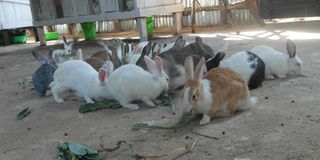Prime
How to profit from keeping rabbits

Keeping rabbits is a viable farm business in Uganda. PHOTO BY ROBERT MUHEREZA
What you need to know:
- Rabbit farming is easier and more profitable than other animal farming because it requires very little capital with a small space to start, and it is a very profitable animal
Rabbit farming is not only profitable but also enjoyable. One can raise a rabbit as a pet and keep rabbits on a small land without much investment. Rabbits have been reared in our country for a long time. There are many benefits to commercial rabbit farming.
Rabbit is a beautiful and small animal. They are tender and therefore a good source of meat. Rabbit farming is relatively simple, profitable, and takes up less space than other livestock activities. It can provide a very valuable additional source of income in rural areas.
Profitable
Rabbit farming is also known as cuniculture. It is defined as raising domestic rabbits for their meat, fur, or wool as livestock. Rabbit farming is practiced by scientists in science as model biology in the use and management of rabbits.
Rabbit farming is easier and more profitable than other animal farming because it requires very little capital with a small space to start, and it is a very profitable animal. Depending on the climate, location, and size of the farm, housing plays an important role in rabbit farming.
Water availability
Rabbits need more water. Cages need water to wash and clean. The snake, woodpeckers, and dogs are enemies of rabbits.
Cold weather is perfect for rabbits. Excessive air humidity can make rabbits sick. The cage should have good feeding and watering facilities.
Housing should be an attached building with adequate ventilation, lighting, heating, and cooling systems.
Heating and ventilation are important because rabbits do not tolerate extremes of temperature. You should maintain a 12-hour herd in light and dark each year to maintain a year-round rabbit breeding.
Clean cages
Hutch system can be adopted for small size rabbit farms which is a self-made cage low nest box with its roof.
In the case of large farms, the cages inside the sheds can be arranged in single or double tires under a hanging or stepwise rack system. Provide adequate space for each rabbit floor.
The rabbit roof should preferably be made of asbestos, wood, chaff, or other locally available cheap materials. Build the shed so that birds of prey and birds do not enter the shed. In the case of open huts, adequate fencing should be provided to protect the rabbits from their predators. Build rat-proof civil structures to store feed and wool.
To keep it free from flies/mosquitoes, keep the shed/pan clean by regular cleaning and disinfection and a foot dip should be arranged at the entrance of the shed.
Rabbit cages should be cleaned regularly, especially sterile before kindling. The cage/hutch nest box should be kept clean during burning so that the cats do not catch diseases such as coccidia.
Feeders and waterers should be cleaned regularly and mash feed should be removed from the feeder which can be used for feeding other animal species.
Playing space
If you promote them commercially, at least running / exercise space should be considered (worth three hops). This is important and guarantees a healthy pet.
Maintaining these cages is as important as getting the perfect cage. Good care increases productivity reduces disease, promotes good health, and is directly linked to more successful rabbit farms.
You should keep does and bucks in separate pens and only keep them together throughout the growing season. Keep the hutch in a sunny place and let in the fresh air. Provide nest boxes on time for breeding.
Your rabbit needs these exercises to stay fit and healthy. Rabbits that lack exercise have health problems. You need to make room for a water bottle, feeder, litter box as well as some toys to keep your rabbits from getting bored. So, always choose the biggest rabbit hutch that works for you – the one that you can afford and the one that will fit where you need it.
Systems
Rabbits can be reared in either of the 2 systems. They are the deep litter system or the cage system. Proper shelter is essential to protect rabbits from heat, rain, and cold, as well as from predators such as cats and dogs. Sheds can be made in the backyard with very little investment.
Generally rabbits can eat all kinds of grains, beans, and green fodder such as Lucerne, Agathi, Desmanthus, and various kitchen wastes including carrots, cabbage leaves, and other vegetable wastes.
Mating and calving of rabbits
Mating can occur at the age of 6-8 months. The female rabbit is mixed in the male rabbit’s cage. If the male rabbit is kept in the cage of the female rabbit, the female rabbit which does not want to share the nest can attack the male rabbit and kill them. Male rabbits can be used for mixing 3-4 times a week. The gestation period of rabbits after mating is 28 to 32 days. If she is pregnant, we can start preparing the delivery room with grass from the 23rd day. On the 28th day, a specially prepared box should be kept in the cage for delivery.
Marketing tips
Marketing rabbit products is not easy in some areas. So, it would be better if you decide on your marketing plan before you start. Initially, you can try local markets or the nearest town.




